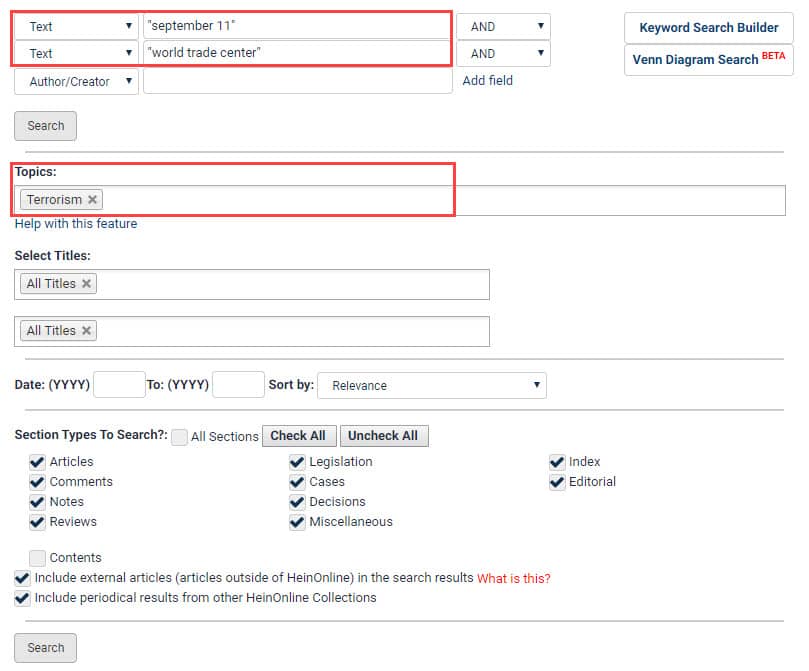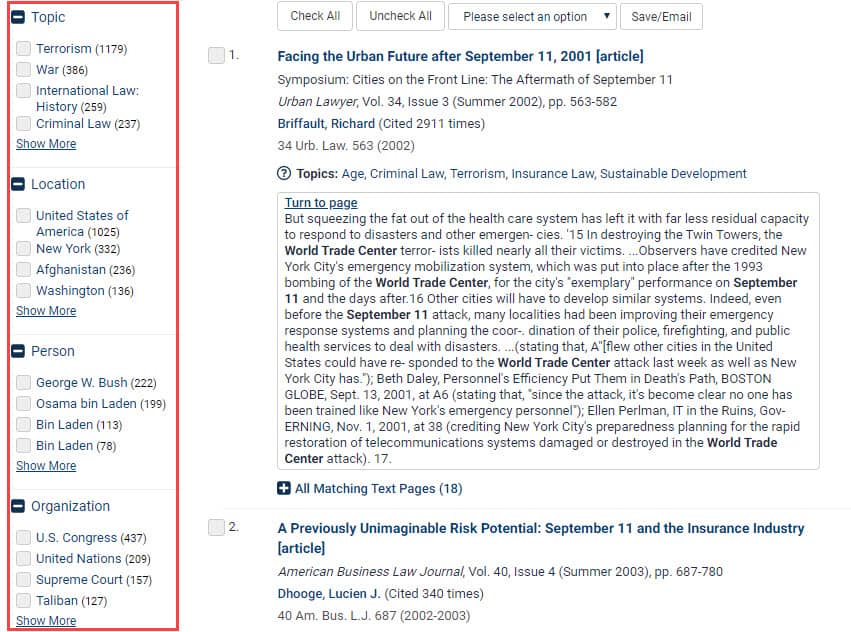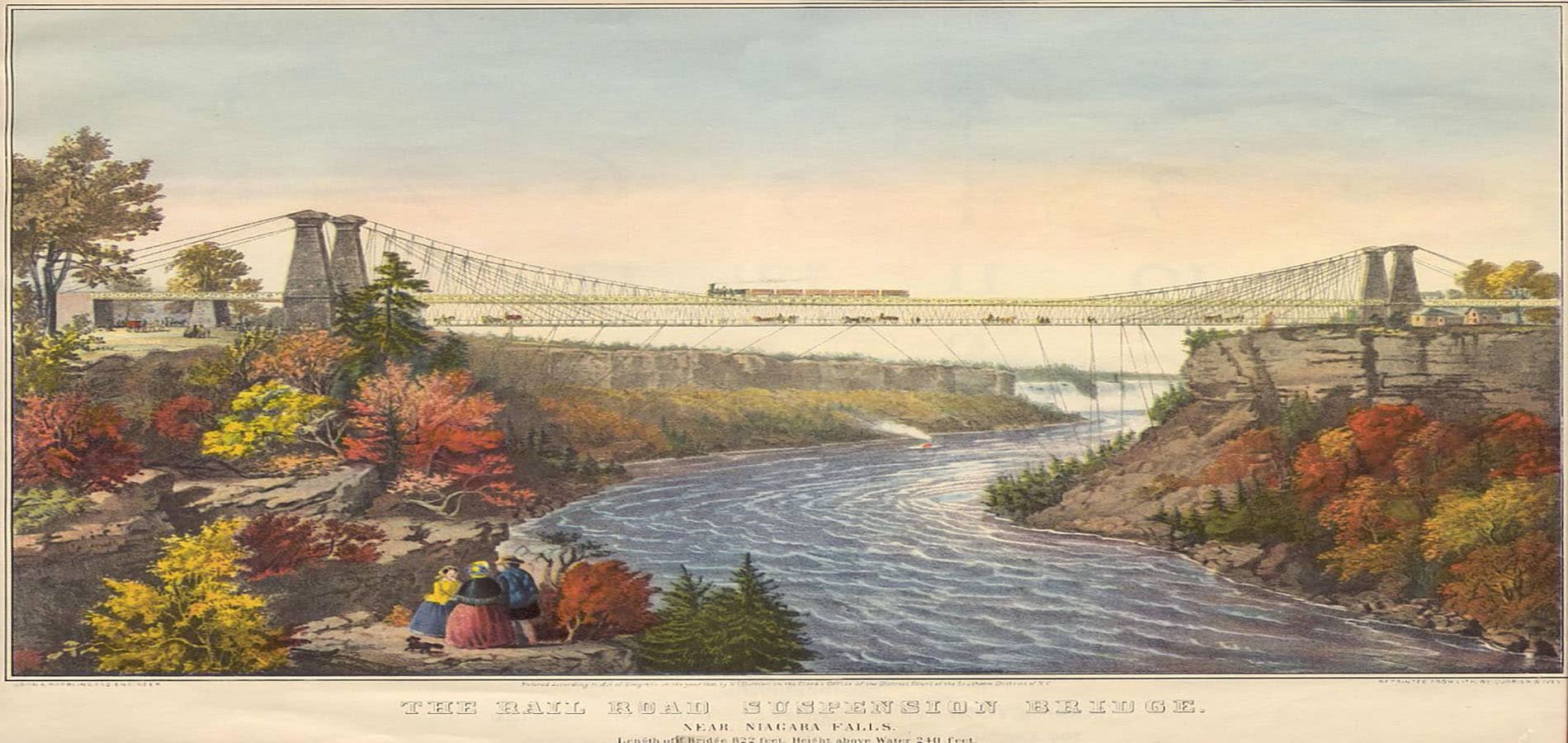On this day in 2001, the United States experienced the single worst terrorist attack in human history. The morning of Tuesday, September 11 saw four separate but coordinated attacks in various U.S. locations, which killed 2,966 people, injured more than 6,000 others, and resulted in billions of dollars in damages. The events of September 11th shocked the world, paving the way for a more aggressive, preemptive U.S. approach to foreign policy and national security. Join HeinOnline in understanding the tragedy and researching its impact as we remember the fallen.
Before We Get Started:
Don’t miss out! Make sure you have the databases we’ll be mentioning in this post. Follow the links below to start a trial today.
- U.S. Presidential Library
- Reports of U.S. Presidential Commissions and Other Advisory Bodies – Named to the 2018 List of Best Historical Materials
- U.S. Statutes at Large
- Code of Federal Regulations
- Law Journal Library
The September 11 Terrorist Attacks
Background
The source of the September 11th attacks was soon discovered to be al-Qaeda, a global terrorist organization which believed that America was conspiring to eliminate Islam. Al-Qaeda’s leader, Osama bin Laden, and prominent members Khalid Sheikh Mohammed and Mohammed Atef were later revealed to be the primary architects of the attacks. Khalid Sheikh Mohammed, a strong opponent of U.S. support for Israel, presented his plan for a terrorist attack to bin Laden in 1996. Bin Laden approved the plot by 1999, believing that the United States was operating under an immoral form of government guided by a starkly anti-Muslim foreign policy.
Over the next few years, Osama bin Laden and his colleagues hand-selected a total of 19 recruits intended to discreetly blend into American culture while preparing for an inside attack on the country.
Overview of the Attacks
On September 11, 2001, the 19 recruits split into groups and boarded four large domestic flights bound for the West Coast. Once in the air, each group forced their way into the cockpits and took control of their respective planes:
- American Airlines Flight 11, flying out of Boston en route to Los Angeles, was flown into the North Tower of the World Trade Center in New York City at 8:46 a.m.
- United Airlines Flight 175, also flying out of Boston en route to Los Angeles, was flown into the South Tower of the World Trade Center at 9:03 a.m.
- American Airlines Flight 77, flying out of Washington D.C., en route to Los Angeles, was flown into the Pentagon in Arlington, Virginia at 9:37 a.m.
- United Airlines Flight 93, flying out of Newark en route to San Francisco, crashed into a field in Pennsylvania at 10:03 a.m. after passengers attempted to thwart the hijackers. The target of this fourth hijacked flight was suspected to be either the White House or the U.S. Capitol Building.
At 9:45 a.m., the United States implemented its Plan for the Security Control of Air Traffic and Air Navigation Aids (SCATANA), grounding all U.S. air traffic. After the collapse of the first tower at 10:03 a.m., Vice President Dick Cheney gave the order, confirmed by President Bush, to shoot down any commercial aircraft that could be identified as hijacked.
The four crashes caused the deaths of nearly 3,000 people and the injuries of more than 6,000 others, leading the events to be deemed the deadliest terrorist attacks in human history. The World Trade Center attacks alone caused the deaths of more than 2,600 people, as more than 90% of those in the towers were at or above the points of impact. Those trapped in the towers perished either due to the impact itself, smoke inhalation, or by falling or jumping from the tower windows. In the Pentagon, 125 civilians and military personnel were killed. None of the passengers on the four planes survived.
The attacks were covered in real-time by various television and online news outlets, triggering a global media event of an unprecedented scale. By the end of the day, viewers around the world watched as five stories of the Pentagon fell and the World Trade Center buildings collapsed entirely. At 8:30 p.m., President Bush addressed the nation in response to the attacks, famously stating that “we will make no distinction between the terrorists who committed these acts and those who harbor them.”
Use the public papers of President George W. Bush from HeinOnline’s U.S. Presidential Library to find more of his responses, remarks, and letters immediately following the attacks. From the database home page, navigate to the “Public Papers” tab and select the Public Papers of the Presidents of the United States. Choose George W. Bush and the second 2001 book. Scroll to find the date of September 11 and beyond.

The Aftermath of the Tragedy
Investigating the Attacks
Following the tragedy, several investigations and inquiries were opened to identify the origin of the attacks, provide a detailed account of the circumstances involved, review the preemptive actions of the intelligence community, and review the World Trade Center’s previous building design and safety.
Perhaps the most notable inquiry, the National Commission on Terrorist Attacks Upon the United States (the 9/11 Commission) was initiated in November of 2002 to detail the background and specific circumstances of the September 11 attacks as well as provide recommendations for preventing similar events in the future. After extensive interviews and testimonies, the Commission concluded that the attacks could have been prevented by more thorough and aggressive action from the U.S. Central Intelligence Agency (CIA) and the Federal Bureau of Investigation (FBI).
Users can view the final report of the 9/11 Commission in HeinOnline’s Reports of U.S. Presidential Commissions and Other Advisory Bodies. From the Commission Reports Index, users have the option to browse by president, commission name, commission subject, and report title. Choose to browse by president, and select George W. Bush to see the 9/11 Commission listed as the second entry.
U.S. Foreign Policy Changed Forever
Reeling from the tragedy and plagued by suspicion, U.S. foreign policy quickly evolved to favor preemptive counter-terrorism efforts. Two days after the attacks, the North Atlantic Treaty Organization (NATO) invoked Article 5 of its North Atlantic Treaty for the first time, committing each member state to consider an armed attack against the United States to be an armed attack against them all. The next day, Congress signed the Authorization for Use of Military Force (AUMF) into law, specifically granting President Bush the use of “necessary and appropriate force” against those responsible.
Two weeks later, Bush addressed a joint session of Congress and the nation and issued an ultimatum to the Taliban government of Afghanistan—give up Osama bin Laden and other al-Qaeda leaders operating within the country, or face attack. Upon their refusal, the United States invaded Afghanistan in the following month, officially beginning the “War on Terror.”
Soon after, President Bush signed into law the USA PATRIOT Act to strengthen national security, enhance surveillance procedures, bolster border security, and further combat terrorism. The following year, Congress passed the Homeland Security Act of 2002, creating the Department of Homeland Security in the most significant modern restructuring of the U.S. government. Since the initiation of the War on Terror and the strengthening of counter-terrorism legislation, several terrorist plots targeting the United States have been thwarted.
Scholarly Work on the 9/11 Attacks
The attacks of September 11th forever changed the world, and specifically impacted the areas of politics, law, economics, international relations, and more. Keep up to date on scholarly work relating to 9/11 with HeinOnline’s Law Journal Library. From the database home page, perform an Advanced Search by clicking the hyperlink underneath the main search bar. Search for documents relating to 9/11 and terrorism by adjusting the drop-down boxes while selecting the topic of “Terrorism,” as shown below.

Select the “Search” button to view nearly 1,200 related results. Refine your search by topic, state or country, person of interest, organization, and more by using the facets on the left-hand side of the search results.

Do you enjoy learning about highlights in history? Are you eager to catch up on current events? Perhaps you’d rather dive into fun, random subjects like Star Wars, drones, turtles, or circus elephants? The HeinOnline Blog posts about these topics and more. Subscribe to the HeinOnline Blog to stay in the loop.
Don’t forget to connect with HeinOnline on our social media platforms: Facebook, Twitter, Instagram and YouTube.



